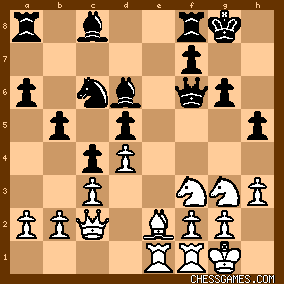| KEG: Maroczy outplayed Sterling in the opening, had a won game by about move 15, and--with the exception of a glitch on move 20--never let Sterling back into the game. But saying that victory was "just a matter of technique" does not capture the hard work Maroczy had to do, and the pitfalls he had to avoid, to win this game. Sterling's play against Maroczy's Sicilian Defense was poor. His 4. Ne2 gave him a bad game from the very start. His 7. Be3 allowed Maroczy to seize the initiative with 7...c4, and his 15. Rae1 got his position fatally tangled up (15. Rfe1 was clearly much better). After Maroczy's 15...h5, Sterling had to play 16. h4 to halt the advance of Black's h-pawn. After 16. h3, Sterling was busted: 
click for larger viewHad Maroczy played 16...h4, Sterling would have been tied up in knots. But, curiously, Maroczy played 16...Bf4 here and did not--though he should have--play h4 on moves 17, 18, 19, or 20. Note that had Maroczy played 20...h4, 21. Nxh4 by Sterling would have allowed mate in 1 with 21...Bh2 mate! Maroczy's 20...Qd7 was a mistake, and Sterling had his first and only true chance to get back in the game with 21. Ng3. Sterling's inferior 21. Ne5 allowed Maroczy to unleash a brilliant winning combination. After 21. Ne5 NxN 22. dxN the position was as follows: 
click for larger viewMaroczy here played 22...Bxh3!! Had Sterling responded 23. gxB he would have been blown away with 23...Qxh3 24. Ng3 h4! Sterling actually played 23. Bf3, and was thereupon down a pawn in a lousy position after 23...Be6. Game over? Hardly. Sterling refused to concede and made Maroczy work very hard over the course of the next 31 moves to close out what looks like a routine win. I will detail the problems Maroczy had to over come to win this "won game" in subsequent posts. | 




